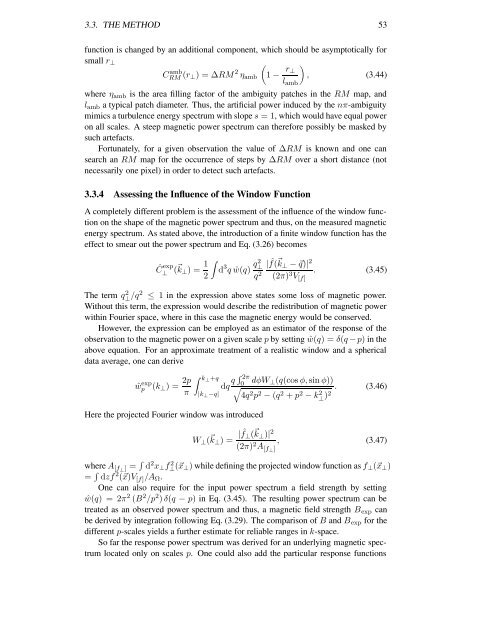Investigations of Faraday Rotation Maps of Extended Radio Sources ...
Investigations of Faraday Rotation Maps of Extended Radio Sources ...
Investigations of Faraday Rotation Maps of Extended Radio Sources ...
Create successful ePaper yourself
Turn your PDF publications into a flip-book with our unique Google optimized e-Paper software.
3.3. THE METHOD 53<br />
function is changed by an additional component, which should be asymptotically for<br />
small r ⊥<br />
(<br />
CRM amb (r ⊥) = ∆RM 2 η amb 1 − r )<br />
⊥<br />
, (3.44)<br />
l amb<br />
where η amb is the area filling factor <strong>of</strong> the ambiguity patches in the RM map, and<br />
l amb a typical patch diameter. Thus, the artificial power induced by the nπ-ambiguity<br />
mimics a turbulence energy spectrum with slope s = 1, which would have equal power<br />
on all scales. A steep magnetic power spectrum can therefore possibly be masked by<br />
such artefacts.<br />
Fortunately, for a given observation the value <strong>of</strong> ∆RM is known and one can<br />
search an RM map for the occurrence <strong>of</strong> steps by ∆RM over a short distance (not<br />
necessarily one pixel) in order to detect such artefacts.<br />
3.3.4 Assessing the Influence <strong>of</strong> the Window Function<br />
A completely different problem is the assessment <strong>of</strong> the influence <strong>of</strong> the window function<br />
on the shape <strong>of</strong> the magnetic power spectrum and thus, on the measured magnetic<br />
energy spectrum. As stated above, the introduction <strong>of</strong> a finite window function has the<br />
effect to smear out the power spectrum and Eq. (3.26) becomes<br />
Ĉ exp<br />
⊥ (⃗ k ⊥ ) = 1 ∫<br />
d 3 q ŵ(q) q2 ⊥ | ˆf( ⃗ k ⊥ − ⃗q)| 2<br />
2<br />
q 2 (2π) 3 . (3.45)<br />
V [f]<br />
The term q⊥ 2 /q2 ≤ 1 in the expression above states some loss <strong>of</strong> magnetic power.<br />
Without this term, the expression would describe the redistribution <strong>of</strong> magnetic power<br />
within Fourier space, where in this case the magnetic energy would be conserved.<br />
However, the expression can be employed as an estimator <strong>of</strong> the response <strong>of</strong> the<br />
observation to the magnetic power on a given scale p by setting ŵ(q) = δ(q −p) in the<br />
above equation. For an approximate treatment <strong>of</strong> a realistic window and a spherical<br />
data average, one can derive<br />
ŵp<br />
exp (k ⊥ ) = 2p ∫ k⊥ +q<br />
π |k ⊥ −q|<br />
Here the projected Fourier window was introduced<br />
dq q ∫ 2π<br />
√ 0 dφW ⊥ (q(cos φ, sin φ))<br />
4q 2 p 2 − (q 2 + p 2 − k 2 ⊥ )2 . (3.46)<br />
W ⊥ ( ⃗ k ⊥ ) = | ˆf ⊥ ( ⃗ k ⊥ )| 2<br />
(2π) 2 , (3.47)<br />
A [f⊥ ]<br />
where A [f⊥ ] = ∫ d 2 x ⊥ f 2 ⊥ (⃗x ⊥) while defining the projected window function as f ⊥ (⃗x ⊥ )<br />
= ∫ dzf 2 (⃗x)V [f] /A Ω .<br />
One can also require for the input power spectrum a field strength by setting<br />
ŵ(q) = 2π 2 (B 2 /p 2 ) δ(q − p) in Eq. (3.45). The resulting power spectrum can be<br />
treated as an observed power spectrum and thus, a magnetic field strength B exp can<br />
be derived by integration following Eq. (3.29). The comparison <strong>of</strong> B and B exp for the<br />
different p-scales yields a further estimate for reliable ranges in k-space.<br />
So far the response power spectrum was derived for an underlying magnetic spectrum<br />
located only on scales p. One could also add the particular response functions
















